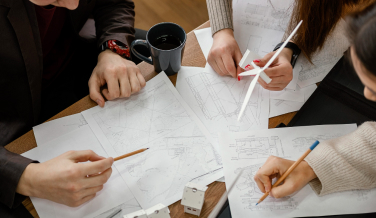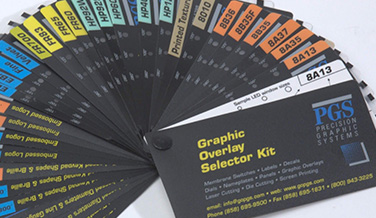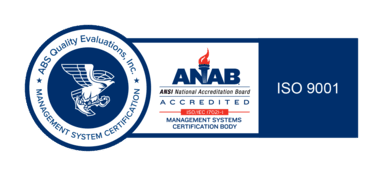You’ll have plenty of choices when specifying graphic overlay or fascia panels, so we’d like to help youchoose the right materials, specify the correct adhesive, create the production drawings, and keep the manufacturing cost to a minimum.
Graphic Overlay & Control Panel Design Guide
You’ll have plenty of choices when specifying graphic overlay or fascia panels, so we’d like to help you choose the right materials, specify the correct adhesive, create the production drawings, and keep the manufacturing cost to a minimum.
The Material World
Graphic Overlays – The Base Material
The graphic overlay starts out as a clear plastic film made from one of two types of plastic, a thermoset plastic, such as polycarbonate (best known by the GE registered trademark of Lexan®) or a thermoplastic such as PET (also know as polyester (under the Dupont trade name of Mylar®).
These clear plastics come in a wide range of film thickness, from .003” to .030”. The most commonly used graphic overlay thickness is within the .005” to .015” range.
There are more than 20 commonly used graphic overlay materials, offering different textures, chemical resistances, UV protection, gloss levels, flammability resistance and more.
Each of these materials comes in a variety of thickness. When specifying the “best” overlay material, the product designer has to consider many variables, but whichever material you choose, a graphic overlay will outperform almost any other type of marking or labeling material available.
Getting to Know Poly – Polycarbonate vs. Polyester
Polycarbonate was first discovered in the early 1950’s, and became a commercial product with the GE trade name Lexan® in the late 1950’s. Lexan resin is used in thousands of products from replacement windows, to CD’s. Film gauge polycarbonate is the material that started the “graphic overlay revolution”, replacing the traditional etched, engraved, or printed metal nameplate with a material that was less expensive, nearly as durable, and far easier to process and fabricate.
The Polyester we know today was developed by Dupont and is known by the trade names of Mylar® and Melinex®, among others. Polyester was developed only a few years after polycarbonate and was not commonly used for graphic overlays until the late 1980’s, but it has made significant inroads due primarily to its superior chemical resistance and better mechanical properties when compared to Polycarbonate films.
Since polycarbonate film has been used for over 50 years, it is often specified on legacy blueprints or drawings. Polycarbonate remains an excellent choice for many graphic overlay applications, but the product designer might want to consider polyester as an option, especially if harsh chemical environments*, or button cycle life is a concern.
Below is a chart that highlights some of the differences between the two materials. For a more technically oriented comparison, see our graphic overlay technical specs page.
*Note: Chemical resistance varies, depending on types of solvents used. Some polycarbonate is available with hard-coat surface treatments, which greatly improve chemical resistance.
Choosing Poly – The Right Match for You
As you can see, the polyester material has a bit of an edge over the polycarbonate material in almost every category, but there are a few exceptions.
The first is cost. Polycarbonate is often less expensive than comparable polyester material. Both materials can be embossed, but since Polycarbonate has a lower yield strength, it will hold fine lines and detail better, and will emboss deeper than polyester.
Polyester performs much better under repeated flexing, so if you want to emboss a keypad, where cycle life is a prime consideration, choose polyester. If you are embossing small details like Braille, or graphic logos that are not repeatedly flexed, then polycarbonate is the better choice.
Another difference not evident in the chart above is selection.
When it comes to thickness, textures, surface coatings, and flame ratings, there are far more polycarbonate films to choose from. The common thicknesses available for polycarbonate are .005, .007, .010, .015, .020, and .030”.
While common polyester gauges are .006”, .008, and .010”, Polycarbonate offers more selection with different textures and finishes, including chemical resistant, and anti glare coatings. But even without coatings, polyester is more chemically resistant than polycarbonate films. Unless your product is expected to encounter extreme chemical or abrasive environments both materials will perform well.
When selecting the best graphic overlay material for your product labeling needs, there are three important factors to consider: performance, cost, and aesthetic appeal.
Each product has its own unique requirements, depending on the expected product life and the conditions in which it is used. If you have questions about specific applications please call or e-mail us with your project details, and our engineering staff will be happy to offer some recommendations.
PGS has developed a graphic overlay selector kit to help you with the aesthetics of selecting the right material.
Contact us for Your Free Graphic Overlay Selector Kit
Contact us now (link to contact page) to receive your free graphic overlay selector kit. The kit provides you with printed samples of the most frequently used graphic overlay materials. The Graphic overlay selector kit will also include embossed samples, adhesive samples and technical information about each of the materials.
If you have questions or need assistance with choosing a material, please call and ask to speak with someone in our sales or engineering department.
Adding The “Graphic” to the Graphic Overlay
Text, graphics and background color are usually screen printed on the back of the clear overlay material. This is called “subsurface printing” or “second surface printing”.
Any number of colors can be printed on this material, including transparent colors for window displays, and translucent colors for deadfront graphics. The colors are usually printed from darkest to lightest, and gradations or halftones should be avoided if possible. If your design requires gradations, fades, or blends of colors, the overlay can be printed digitally with excellent results. Since the graphics are printed subsurface they are protected from abrasion and chemicals by the overlay material itself. This makes it one of the most durable labeling methods available.
A Few Words About Color
Color is one of the first things people respond to. At PGS we understand that color plays a significant role in your product’s design, greatly affecting the product’s perceived quality or value.
Color is usually specified by using the Pantone Matching System or PMS colors.
This color matching system now offers over 1000 colors including metallics. The PMS was designed for offset printing onto paper materials. The Pantone swatch book has two sets of colors with a 3 or 4 digit number for each color, followed by either a “C” or “U”.
This system was designed to demonstrate how a particular ink will appear on either coated or uncoated paper. We match our colors using computerized color formulas, but because we’ll be printing on the backside of a plastic film rather than the top of paper, slight variations in color may occur.
Please specify either “C” or “U” for the color you’d like us to match. For critical color match applications be sure to request a printed color swatch for your approval prior to production, or you can send us a previously printed color sample that we can match.
If you’d like to match the background color of the graphic overlay to your plastic or metal enclosure, it would be best to furnish us with a sample enclosure or color chip to color match to. The Pantone System has a limited range of off-white and other neutral colors that are frequently used for enclosures. Keep in mind each color we screenprint (including the background color) requires an additional film, screen, and set up, which has a direct effect on the cost of your graphic overlay.
We love printing complex, multicolored graphic overlays, but if cost is a major concern, consider limiting the number of colors used in your design. If you need a full color overlay, also known as process color, we can accomplish that with digital printing. There is no limit on gradations or blends with digital printing, but keep in mind that metallic colors and exact matches to some custom logo colors may be limited with the digital process.
How to rise above the crowd.
Once the overlay is printed, you’ll have the option to have it embossed. Although not required, embossing is a great way to make your logo literally rise above the rest. But that’s not the only reason to add embossing to your graphic overlay. If your product is used in low light situations, or even bright light situations where the users attention needs to be elsewhere when operating your product, embossing is a great way to give the end user non-visual feedback with embossed keys or other features.
For applications such as ATM machines that require instructions in Braille for the visually impaired, embossed graphic overlays are a great way to incorporate this feature along with regular instructions for the non-visually impaired. Both can be combined in one economical label.
The Sticky Get Stuck
We are not done yet with our graphic overlay. We still have to laminate adhesive to the back of the printed graphics.
Since this adhesive is added after the graphic overlay is printed, and not part of the overlay material as it comes from the manufacturer, we can select from a wide range of adhesives. Each adhesive is matched for a particular application.
Whether the graphic overlay is going to be used in a high or low temperature application, applied to a rough or textured surface, or even stuck to a low surface energy plastic like polystyrene or polypropylene, we will tailor the adhesive to the exact application.
Another benefit of adding adhesive after printing is that we can die cut or laser cut patterns or shapes out of adhesive sheets before they are laminated to the back of the graphic overlay.
This is called selective adhesive and it allows us to leave selected areas on the back of the overlay free of adhesive. Clear windows for LED or LCD displays or overlay discrete key switches are just two examples of when to use a selective adhesive. The other part of the adhesive is the release liner, which covers and protects the adhesive until your graphic overlay is ready to be used.
But we still haven’t discussed the top surface of the graphic overlay.
The Surface on Top
The top of the graphic overlay is what your customer touches. It doesn’t just protect the graphics on the backside. The overlay material is available from the factory with a wide selection of surface treatments, such as glossy or antiglare and a variety of textures.
If your product calls for more than one texture, these can be printed as well. Generally, a textured surface is chosen to match a products enclosure, as well as to hide fingerprints when an overlay is covering a keypad or other buttons. But if a LED or LCD display is present behind a graphic overlay window, it may be desirable to have a gloss or anti-glare finish on the overlay to enhance the view-ability of the display.
To get the best of both worlds, a texture or gloss hardcoat can be screen-printed on the top surface. This gives the product designer ultimate control over the look and usability of a product, since multiple textures can be applied to the same graphic overlay surface.
Making it all Fit Together
Now that the graphic overlay has been printed and laminated with adhesive, it is ready to be cut to what ever shape you need.
Most graphic overlays are cut with steel rule dies, which is the most economical process for medium and long production runs. Please keep these guidelines in mind when specifying graphic overlays that will be die cut with steel rule dies.
° Keep corner radii to .03” or larger (square corners are ok)
° Specify standard fractional or metric size holes when possible
° Avoid feature shapes that require cutting rule to be .050” or closer.
° Keep all tolerances to ± .010” or .±015” if possible
When compared with two-part hard tooling, steel rule dies are inexpensive cutting tools made by bending sharpened steel rules or knife blades and inserting them into a wood base material. The wood base material is typically laser cut and the best tolerance that can be held with the die itself is ± .005”.
There are limits to how sharp the bend can be made with steel rule, so radii smaller than .03” are not possible. If a thick graphic overlay material such as .020” is used, the thicker rule must also be used, which will require a minimum radii of.06”. Square corners are not a problem and it’s possible to die cut features with spacing smaller than .050”, but it should be avoided if possible.
When the wood that holds the steel rule knife blades is laser cut the tolerance of the die can be held to .005”, but the thin film materials of Lexan and Polyester will change a very small amount after being cut. The interior holes will tend to get smaller or shrink, while the overall size of the part will tend to grow. Keep in mind this is a very small percentage of less than 1%. Thicker materials will be more susceptible to this size change than thinner materials.
Steel Rule dies are pre-adjusted by a fraction of a percent depending on the material being cut. This will help keep tolerances within .010”.
Hole Sizes
Steel rule dies use tubular punches for hole sizes under .75” Diameter. These punches are available in fractional sizes by 1/64” of an inch or common metric sizes. Diameters between the even 64th of an inch are available as a special grind and will add to the cost of the tool. Once you get above .75” diameter the die maker can bend rule and there is not a limit on staying with fractional sizes.
For this reason it is best to specify tolerances of .010” or looser.
The other method of cutting graphic overlays is with laser cutting. Laser cutting is an excellent method for short run, fast turn around, or prototype graphic overlay projects. There is no tooling cost involved. We can cut directly from your CAD file. Some materials may show a slight discoloration on the edges, this is most noticeable on thicker polycarbonate materials with white or light colored backgrounds. Polyester material will tend to cut without this discoloration.
If your graphic overlay needs to fit inside a recessed area of your injection molded part or a machined recess, please include a sample part before ordering so we may check the fit before proceeding with production.
Oversize Graphic Overlays
If you have a product that requires oversize graphic overlays, Precision Graphic Systems is equipped to print and die cut up to 46” in length, though we have printed and cut them larger than that.
If you have a question about graphic overlay materials or applications please call and ask to speak to someone in our engineering department. You can click on our Online Graphic Overlay quotation request form.
If you feel overwhelmed by all the choices of material, or have never seen some of the more unusual graphic overlay materials like Lexan Suede, call or e-mail for our free graphic overlay selector kit. The selector kit includes printed samples of different Lexan materials showing the different textures and hard coated materials available, as well as the most often used polyester overlay materials.
Don’t start your next graphic overlay project without it!
Contact Us to request some sheets for various overlay materials check out our Graphic Overlay Material Links page






